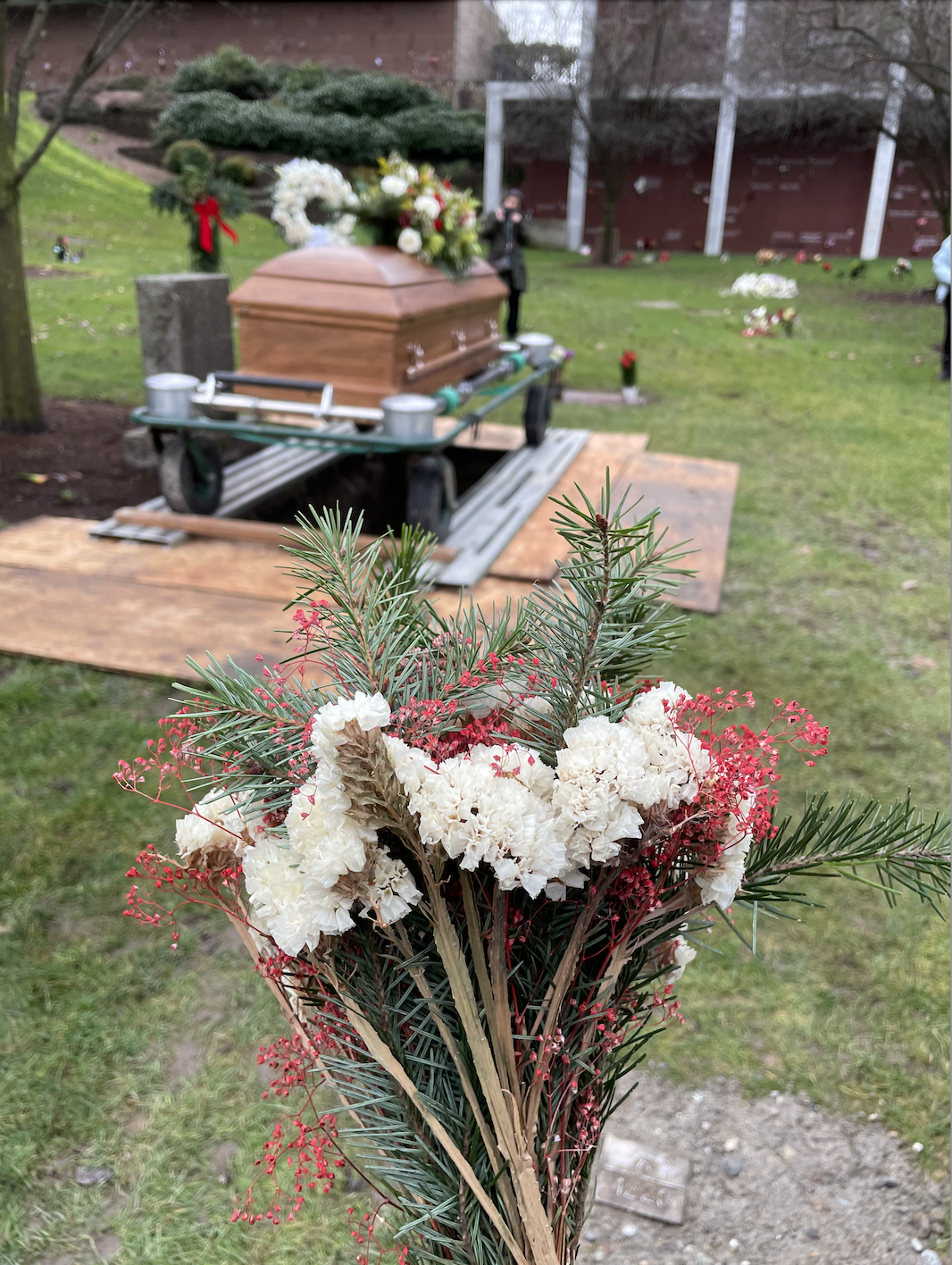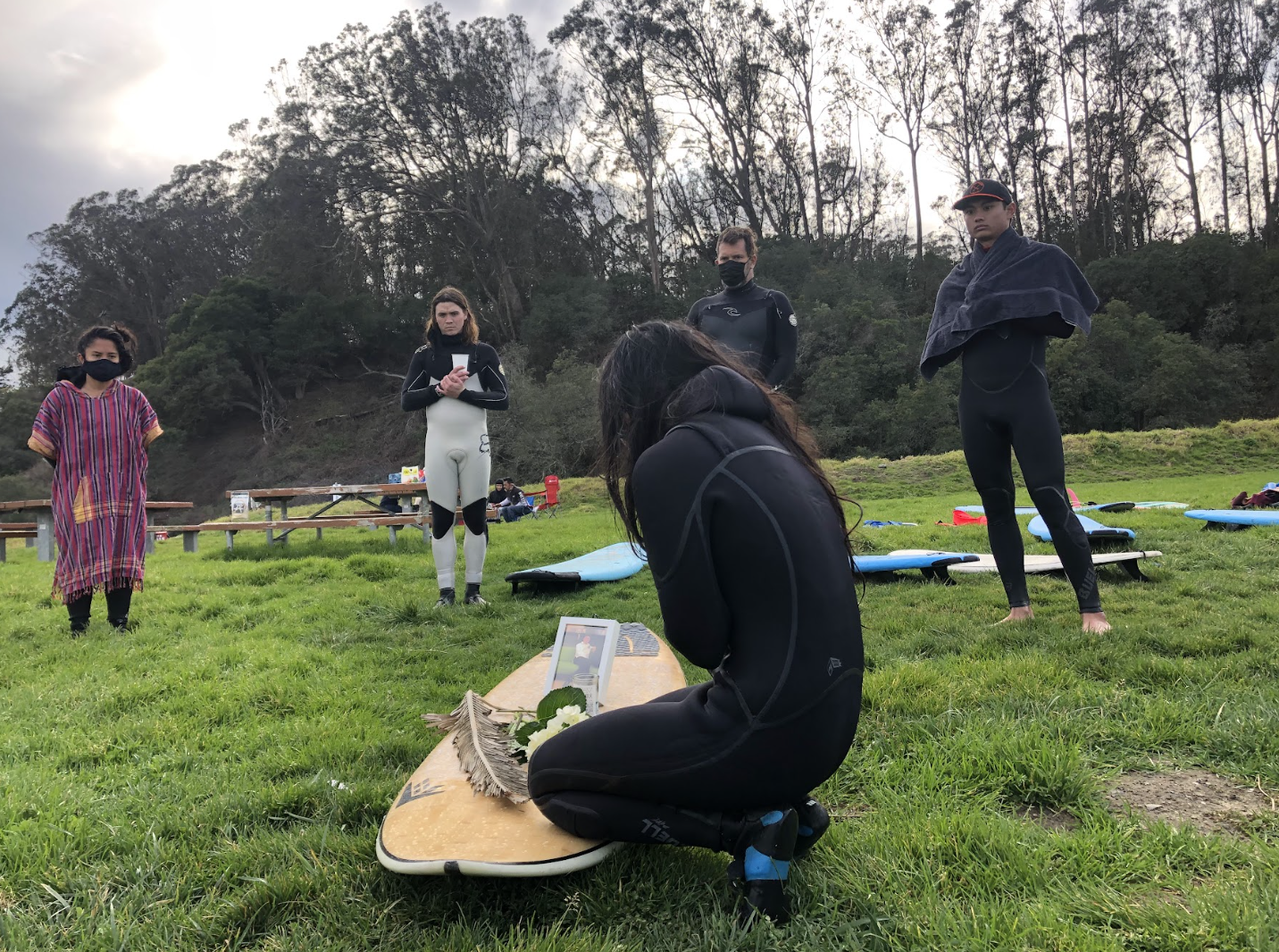Part 2: The Art of Grief at Work: Holding Space for Colleagues and Community
Dad’s Funeral
Seattle, Washington: December 2020
Photo by Melissa Andrada
It’s been close to 2.5 years since my father’s tragic death yet not one day passes that I don’t think of him. Grief is not a weakness; it is an act of courage. We grieve because we love.
“Extraordinary grief is extraordinary love”
As a society, we confine grief to a short period of time; the average allocated time for workplace bereavement is 3-7 days. After the memorial service, the person who has experienced loss is expected to rebound to their previous capacity at work. The reality is that bereaved will grieve for the rest of their lives, including at work.
We need a more innovative and humanistic approach to grief in the workplace. We need to show up for our people, organizations and communities beyond the funeral and early stages of grief. This post is intended to support managers with practical thinking to show up for their colleagues amid enduring grief.
Why this matters?
Psychological Safety is the most important attribute of a high performing team.
In 2022, there were 934.6 deaths per 100,000 people in the United States, which exceeded that of any year between 1972 and 2019.
On average, each person who has died leaves 9 people grieving.
When we make space for our people to grieve at work, we can help them alchemize sorrow and suffering into feelings of community and belonging.
How can you support a colleague holding grief from the less recent death of a loved one?
Sayulita, Mexico
Photo by Spencer Ian Harris
1
Develop an Enduring Grief Compassion Guide.
Uncover the specific needs and potential triggers of the person grieving. Make sure to update it every year, as the person’s needs may change as their grief evolves. You can see the version for the first stage of grief. You can also ask these questions more gently and informally through 1:1 if the Google Form feels too clinical.
2
Simply, just listen.
Sometimes people who are grieving don’t need you to give advice, compare an experience, analyze what happened or solve a problem. We just need you to listen with your full attention, so we don’t feel alone. Attune to what might not be spoken through words, but what is being said through their body. Be mindful of abruptly changing the subject or jumping quickly to tasks without checking in with your colleague to see if there’s anything else they’d like to share about their grief. Read this post on Equitable Coaching for more depth on how to hold space for your people. Ask your colleague what they need in the moment to feel safe and seen.
Demoing how to listen
General Assembly, New York City: October 2019
Photo by Jesse Whiles
3
Normalize feelings and tears at work.
Tears clean the heart. They reset the nervous system. As a leader, you can model vulnerability in your meetings by sharing a time when you cried at work or in a public space. If someone starts crying in a 1:1 or meeting, let them feel what they need to feel. Gently ask or sense into what they might need in the moment -- perhaps time alone to cry privately, a glass of water and tissues, or a listening ear to hold the sorrow of their lost loved one. For the first 18 months of my dad’s passing, I had a self-facilitated practice of crying while listening to a grief playlist on Spotify; the year I cried the most was also one of the most financially abundant years of my consulting practice.
Dad and I shared a love for chess
“This being human is a guest house.
Every morning a new arrival.
A joy, a depression, a meanness,
some momentary awareness comes
as an unexpected visitor.
Welcome and entertain them all!”
— Rumi
4
Be mindful of phrases or behaviors that may trigger harmful experiences of their grief.
Each person is unique. For me, some phrases that I can experience as insensitive, “It’s time to move on”, “Your dad wouldn’t want you to be sad.” or “You’ll find a new photographer.” While these phrases hold good intentions, they create harm for me as the bereaved as they invalidate my emotional needs and my lived experience of grief, making me feel unseen and unsupported. Read #4 of this post that begins with “share compassionate feedback when people say things in response to your grief that feel hurtful” to understand more on why these phrases are problematic.
5
At the end of each year, ask your colleague how they’d like you to hold space for their grief on important anniversaries and holidays related to their lost loved ones.
With one of my former clients, City Surf Project, we organized a Paddle Out in honor of my father’s birthday (01/26/43) with a beautiful reading of the eulogy. This June I’ll be hosting a Pride surf fundraiser in memory of my beloved father and grief photographer and dear friend Spencer, two of my most important queer allies.
Paddle Out with City Surf Project
Crissy Field, San Francisco, California: January 2021
6
Ask your colleague how they’d like you to honor their birthday.
Birthdays can be a difficult time for the bereaved. My grief photographer Spencer and I share the exact same birthdate (03/26/85). My birthday is now a marker of sorrow and celebration. Because of the loss I experienced, I often receive generic wishes for me to have a “Happy Birthday” as empty or even triggering as they fail to recognize my new birthday reality. When friends do take the time to say or write a grief-sensitive birthday message, it makes me feel truly celebrated and honored. To celebrate my life fully, I also have to simultaneously celebrate the death and the life of the person who can no longer physically share this birthday with me.
First Birthday without Spencer
Sayulita, Mexico
Photo by Melissa Andrada
7
Continue to offer hyper sensitive and flexible working to the bereaved, particularly during difficult times of the year (birthdays, anniversaries, holidays).
Make it okay for a person to arrive or leave a meeting early if they are hit with a wave of grief -- and provide a schedule that makes it easy to integrate therapy or coaching. Alongside the standard vacation, sick and mental health days, offer extended annual bereavement leave beyond the typical 3-7 days at the onset of the loss of a loved one.
8
Help someone find a grief therapist, coach or healer specific to their needs.
I’m grateful to have a queer somatic therapist of color who holds a weekly container for my grief and healing. Having a therapist who really ‘sees me’ has been so instrumental in my journey of transformation.
A compilation of therapy directories based in the States where you may find someone specific to your needs:
https://www.inclusivetherapists.com/
https://www.lgbtqpsychotherapistsofcolor.com/
Read #5 of this post on “Get professional support. See a skillful grief-specific therapist or coach, join a values-aligned grief group” to gain more insight as to how to support your colleagues in their search.
Grief Altar
Oakland, California
Photo by Spencer Ian Harris
Grief is an inevitable part of being human. Therefore, it is an inevitable part of our workplaces. Each experience of grief is as unique and singular as a fingerprint. When we allow people to bring their grief to work, we allow them to be fully seen in their humanity. When we allow people to be fully seen at work, we allow them to drop into psychological safety, the foundation for compassionate high performance and innovation.
What are your reflections on how we can most compassionately and effectively support our bereaved colleagues and communities?
Get in touch if you’d like support on a workshop to support the mental health, wellbeing and grief of your people.
Melissa Andrada (Mel - she/they) is a trauma-sensitive DEI Consultant, Keynote Speaker, Workshop Facilitator, Yoga Teacher and Leadership Coach, alchemizing the grief for her beloved father Tito Pamplona Andrada and dear friend Spencer Ian Harris into healing for others. They are currently pursuing a Masters in Expressive Arts Therapy with a concentration on grief at the California Institute of Integral Studies.






